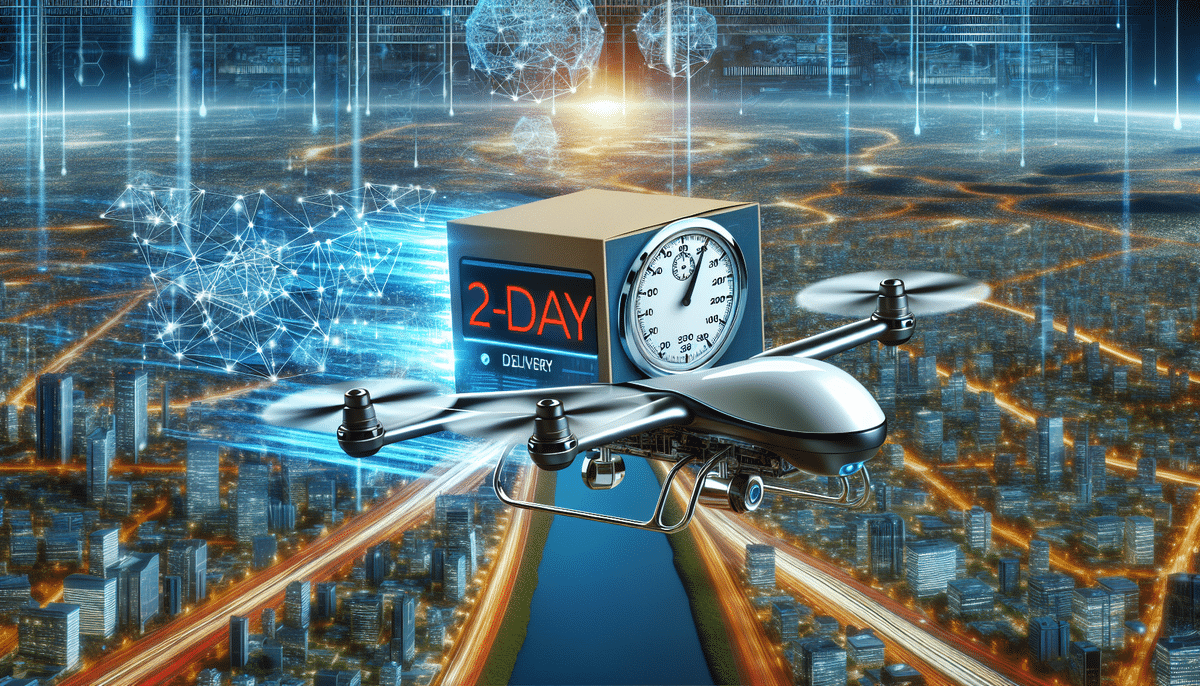Unlocking the Potential of the Fulfillment Innovation Wheel: 2-Day Delivery
The internet has revolutionized the way businesses operate, particularly in the world of e-commerce. One aspect of online shopping that has significantly evolved is shipping time. For many years, delivery times of a week or even longer were the norm, leaving customers frustrated and businesses struggling to meet their needs. However, with the advent of 2-day delivery, the entire e-commerce landscape has transformed.
The Importance of Fast Delivery in the E-commerce Industry
Fast delivery has become increasingly critical in the e-commerce industry. With customers expecting their items to arrive swiftly, businesses must adapt to keep up with demand. Studies have shown that 69% of consumers are more likely to shop with retailers that offer expedited shipping options (Shopify, 2023). Fast delivery times can be a major factor in a customer's decision to make a purchase. For businesses in the e-commerce space, meeting customers' delivery expectations has become a top priority.
One way businesses meet these expectations is through advanced logistics technology. This technology allows for real-time tracking of inventory and shipments, ensuring that items are delivered to customers as quickly and efficiently as possible. Additionally, some businesses have started to offer same-day or next-day delivery options, further enhancing the customer experience and differentiating themselves from competitors. As the e-commerce industry continues to grow, fast delivery will remain a crucial factor in attracting and retaining customers.
Understanding the Fulfillment Innovation Wheel
The fulfillment innovation wheel encompasses various strategies businesses use to enhance their fulfillment processes, including delivery times. By analyzing and improving each step of the process, businesses can unlock the full potential of the fulfillment innovation wheel. Strategic investments in technology, infrastructure, and partnerships can help businesses make significant progress in implementing faster delivery times while also addressing other aspects of the fulfillment process such as inventory management and shipment tracking.
One of the key benefits of implementing the fulfillment innovation wheel is the ability to provide a superior customer experience. Faster delivery times and more accurate tracking information can lead to increased customer satisfaction and loyalty. Additionally, businesses can use data collected through the fulfillment process to make informed decisions about inventory management and product offerings, further enhancing the customer experience.
However, implementing the fulfillment innovation wheel can also present challenges. It may require substantial investments in technology and infrastructure, as well as changes to existing processes and partnerships. Businesses must carefully weigh the potential benefits against the costs and risks before embarking on a fulfillment innovation journey.
The Evolution of Delivery Services in E-commerce
The evolution of delivery services in e-commerce has been rapid. Initially, delivery times of a week or more were commonplace. However, as competition increased and customer demand for faster shipping grew, businesses began offering quicker delivery options. Next-day delivery became the norm, followed by 2-day delivery, which is fast becoming the new standard. As businesses continue to innovate, even faster delivery times are likely to become possible in the near future.
One of the key factors driving this evolution is the rise of same-day delivery. This service, which promises delivery within hours of placing an order, has become increasingly popular among customers who value speed and convenience. Same-day delivery is particularly important for perishable goods, such as groceries and flowers, which need to be delivered quickly to ensure freshness.
Another trend in delivery services is the use of drones and autonomous vehicles. These technologies have the potential to revolutionize the delivery industry by reducing delivery times and costs. Drones can deliver packages to remote areas that are difficult to access by traditional delivery methods, while autonomous vehicles can make deliveries around the clock without the need for human drivers.
How 2-Day Delivery is Revolutionizing the E-commerce Landscape
2-day delivery has revolutionized the e-commerce landscape by providing customers with faster and more reliable shipping options. This is a critical factor for businesses looking to stay competitive in the industry. By allowing customers to receive their products faster, businesses can not only improve the customer experience but also increase customer satisfaction and loyalty. With 2-day delivery rapidly becoming the standard, businesses that fail to keep up with this trend risk being left behind.
Furthermore, 2-day delivery has had a significant impact on the environment. By consolidating orders and optimizing delivery routes, e-commerce companies can reduce their carbon footprint and contribute to a more sustainable future. This is especially important as online shopping continues to grow in popularity and the demand for faster shipping options increases. By embracing 2-day delivery, businesses can improve their bottom line while also making a positive impact on the planet.
Benefits of Implementing 2-Day Delivery for Your Business
- Enhanced Customer Experience: Faster delivery times improve overall satisfaction and encourage repeat purchases.
- Increased Sales: Quick shipping options can lead to higher conversion rates and reduced cart abandonment.
- Competitive Differentiation: Offering 2-day delivery sets your business apart from competitors.
- Wider Reach: Faster delivery enables businesses to expand their customer base regionally and internationally.
- Operational Efficiency: Streamlined logistics and inventory management lead to cost savings and improved profitability.
Implementing 2-day delivery can also help businesses reach a broader audience. With faster delivery times, businesses can expand beyond their local areas and cater to customers in other regions or even countries, leading to increased revenue and growth opportunities.
Additionally, 2-day delivery can help streamline operations and improve efficiency. By establishing a set delivery timeframe, businesses can better plan and manage inventory, shipping, and logistics, resulting in cost savings and enhanced profitability.
Overcoming Challenges to Implement 2-Day Delivery
Implementing 2-day delivery can be challenging, especially for businesses that have never offered this service before. Key challenges include:
- Costs: Investing in faster shipping solutions and technology can be expensive.
- Logistics: Ensuring timely deliveries requires robust logistics and supply chain management.
- Partnerships: Collaborating with reliable carriers is essential for maintaining delivery standards.
To overcome these challenges, businesses can start by analyzing their existing fulfillment processes to identify areas for improvement. Strategic partnerships and investments in technology can help streamline operations and reduce costs. Careful planning and execution are crucial to the success of a 2-day delivery program.
Another significant challenge is managing customer expectations. Customers may expect the same level of service and delivery speed as larger companies like Amazon, which can be difficult for smaller businesses to achieve. To manage these expectations, businesses should:
- Be Transparent: Clearly communicate delivery times and provide regular updates on order status.
- Offer Alternatives: Provide options like express shipping for an additional fee to give customers more control over their delivery experience.
Best Practices for Optimizing Your 2-Day Delivery Process
Optimizing a 2-day delivery process is critical to ensuring its success. Best practices include:
- Automate Processes: Use automation to handle repetitive tasks, reducing errors and speeding up operations.
- Utilize Data Analytics: Leverage data to forecast demand, manage inventory, and optimize delivery routes.
- Create a Customer-Centric Experience: Focus on providing a seamless and enjoyable delivery experience for customers.
Investing in the right technology and building strong partnerships can also help optimize delivery routes and reduce delivery times even further, leading to increased customer satisfaction and loyalty.
Measuring the Success of Your 2-Day Delivery Program
Measuring the success of a 2-day delivery program is essential to ensure it meets customer expectations and delivers a return on investment (ROI) for the business. Key metrics to assess include:
- Delivery Times: Track the percentage of orders delivered within the 2-day window.
- Error Rates: Monitor instances of delayed or incorrect deliveries.
- Customer Satisfaction: Use surveys and feedback to gauge customer happiness with the delivery service.
Additionally, businesses should regularly analyze customer feedback to identify areas for improvement and make necessary adjustments to enhance the delivery experience.
Innovations Driving the Future of E-commerce Fulfillment
The future of e-commerce fulfillment is poised for significant advancements thanks to several key innovations:
- Automation: Automated warehouses and fulfillment centers streamline operations and reduce human error.
- Artificial Intelligence (AI): AI-driven algorithms optimize inventory management and predict customer demand.
- Robotics: Robotics enhance the speed and accuracy of order picking and packing.
- Data Analytics: Advanced analytics provide deeper insights into customer behavior and logistics performance.
- Machine Learning: Machine learning models improve route optimization and delivery forecasting.
By staying abreast of these innovations, businesses can continue to unlock the potential of the fulfillment innovation wheel and maintain a competitive edge in the industry.
How to Stay Ahead of the Competition with Fast and Efficient Delivery Services
In today's competitive e-commerce landscape, delivering fast and efficient services is no longer optional but a necessity. To stay ahead of the competition, businesses should:
- Invest in Technology: Adopt the latest technologies to enhance fulfillment and delivery processes.
- Forge Strategic Partnerships: Collaborate with reliable carriers and logistics providers to ensure timely deliveries.
- Leverage Data Analytics and AI: Utilize data-driven insights to understand customer needs and optimize delivery routes.
- Focus on Continuous Improvement: Regularly review and refine delivery processes to enhance efficiency and customer satisfaction.
Careful planning and execution are key to the success of any fast delivery program. By implementing these strategies, businesses can enhance their delivery services and maintain a competitive advantage.
Case Studies: Businesses that Have Successfully Implemented 2-Day Delivery
Several businesses have successfully implemented 2-day delivery programs, serving as models for others in the industry:
- Amazon: Amazon has made 2-day delivery a cornerstone of its Prime service, offering members expedited shipping on millions of items.
- Walmart: Walmart has invested heavily in its delivery infrastructure to provide faster shipping options, including 2-day and same-day delivery for select products.
- Target: Target offers 2-day delivery through its partnership with Shipt, enhancing convenience for customers and boosting sales.
By analyzing the strategies these businesses have used to implement successful 2-day delivery programs, other businesses can learn valuable lessons and apply those insights to their own operations.
Cost Considerations for Implementing a 2-Day Delivery Program
Implementing a 2-day delivery program can be costly, especially for businesses starting from scratch. Key cost considerations include:
- Technology Investments: Implementing advanced logistics and inventory management systems.
- Operational Costs: Increased expenses related to faster shipping and handling.
- Partnership Fees: Costs associated with collaborating with expedited shipping carriers.
However, the benefits of improving the customer experience and driving sales often outweigh these costs. It is crucial for businesses to carefully evaluate the expenses involved in implementing a 2-day delivery program and identify areas where efficiencies can be gained. Exploring partnerships and technology solutions that can help reduce costs will make the program more sustainable in the long run.
The Role of Technology in Enabling Faster and More Efficient Deliveries
Technology plays a pivotal role in enabling faster and more efficient deliveries. Key technologies include:
- Automation: Automated systems streamline fulfillment processes, reducing manual errors and speeding up operations.
- Artificial Intelligence (AI): AI optimizes inventory management and predicts demand trends.
- Data Analytics: Data-driven insights improve decision-making in logistics and delivery planning.
- Real-Time Tracking: Visibility tools allow businesses and customers to monitor shipments in real-time, enhancing transparency and reliability.
By embracing these technologies and investing in the right partnerships, businesses can enhance the overall delivery experience and stay competitive in the industry.
Future Trends and Predictions for the E-commerce Fulfillment Industry
Looking ahead, the e-commerce fulfillment industry is set to continue evolving rapidly, driven by technological advancements and changing consumer expectations. Key future trends and predictions include:
- Even Faster Delivery Times: The push towards 1-day and same-day delivery will become more prevalent as businesses strive to meet increasing customer demands.
- Increased Automation and Robotics: Greater use of automation and robotics will further optimize the fulfillment process, reducing costs and improving efficiency.
- Sustainable Fulfillment Practices: Businesses will focus more on eco-friendly delivery options to meet consumer demand for sustainability.
- Advanced Data Analytics: Enhanced data analytics and machine learning will enable more accurate demand forecasting and personalized delivery experiences.
- Integration of Emerging Technologies: Technologies such as blockchain for transparent supply chains and Internet of Things (IoT) for smarter inventory management will gain traction.
By staying informed about these trends and proactively adopting new technologies, businesses can continue to improve their fulfillment processes and maintain a competitive edge in the dynamic e-commerce landscape.








